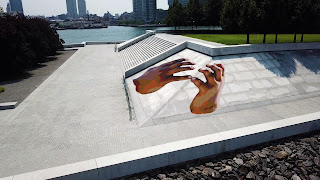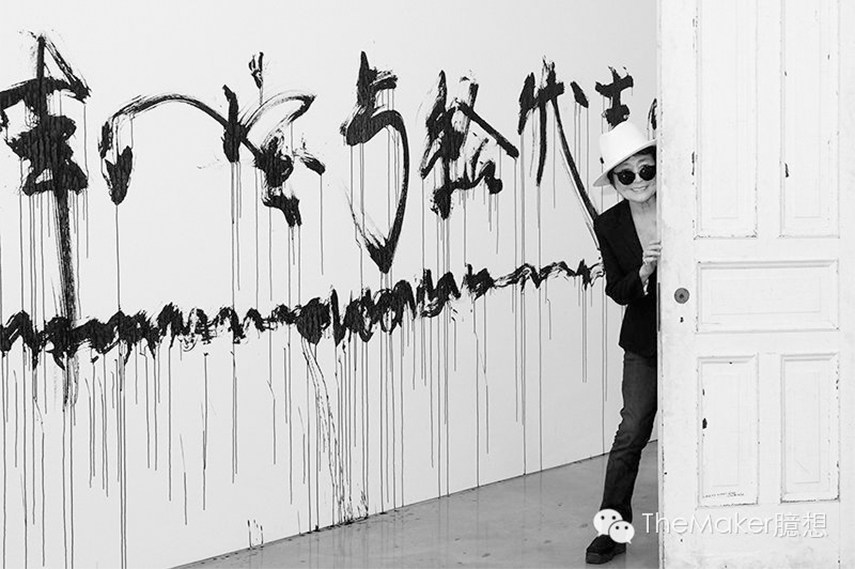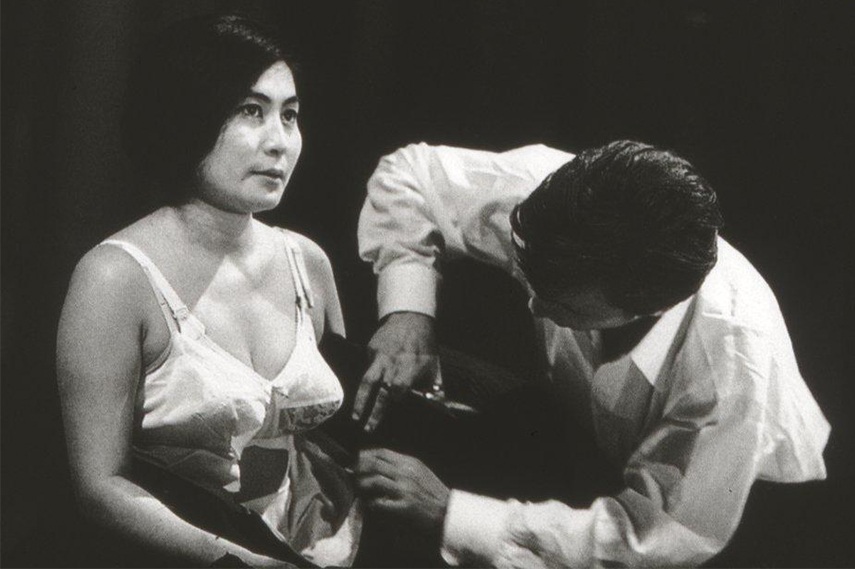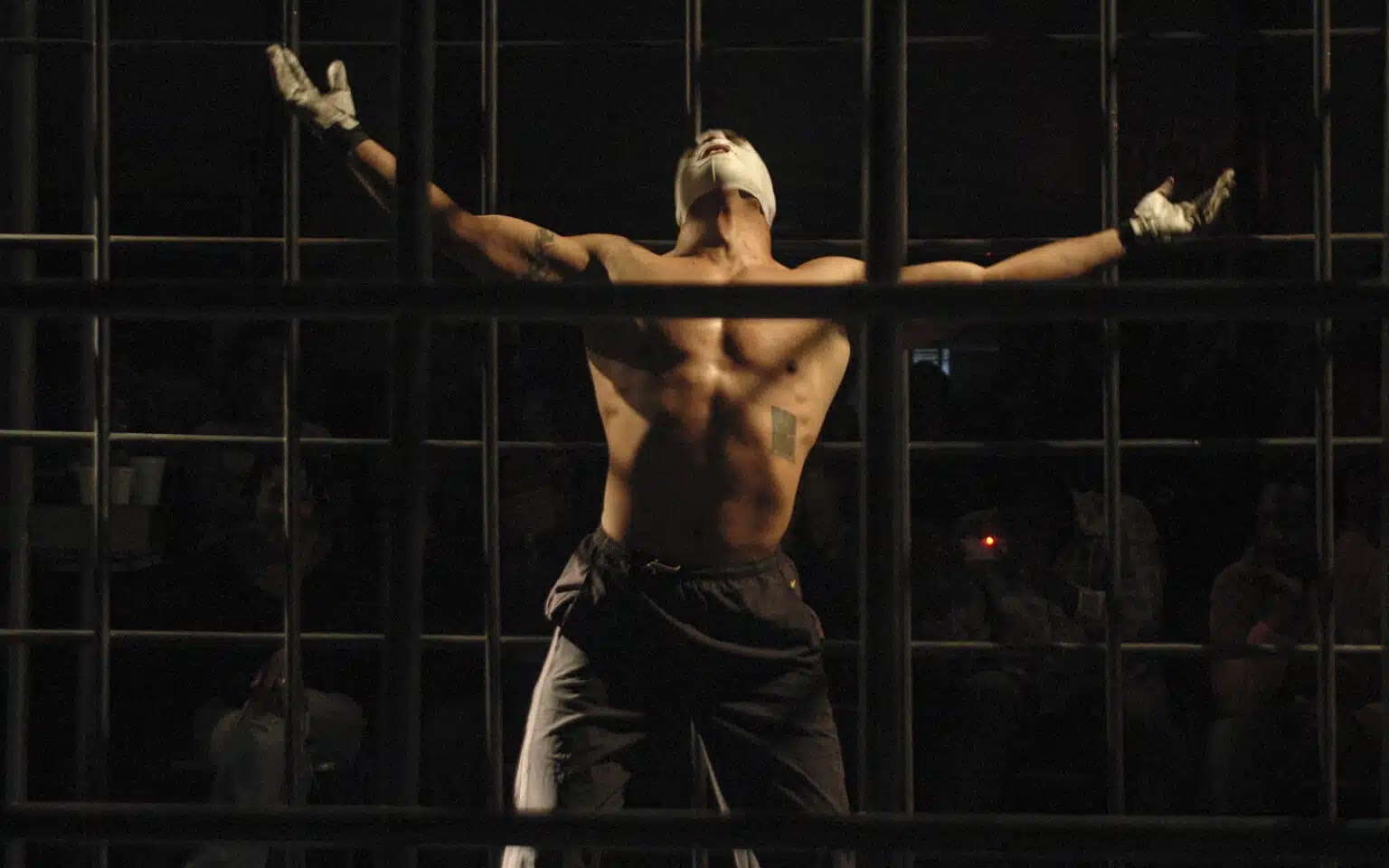Wednesday, March 26, 2025
performance art activism - fatima flores
Tuesday, March 25, 2025
Preformance Art Activism - Teana S. Maitland
Performance Activism
Widewalls | Yoko Ono - A Groundbreaking Artist, Activist and Fighter
Hispanic Executive | Interview with Shaun Leonardo - Performance, Pedagogy, and Philosophy
Battle Royal - Shaun Leonardo
Introduction to Performance and Activism - Scott Bram
Yoko Ono - A Groundbreaking Artist, Activist and Fighter behind the Myth of her Name
Performance, Pedagogy, and Philosophy
Introduction to Performance and Activism | Emmanuel Orellana Monsalve
Widewalls | Yoko Ono - A Groundbreaking Artist, Activist and Fighter
R1: Reading this line during passage made me realize how themes of pieces of art really matter. Due to her work at the time being "radical", it prevented her from gaining popularity. However, her later works with her approach with conceptual art led her to become influential.
Q2: "Her work has always been an indivisible element of her activism and life-long mission of communicating with the world at large. Despite the often hostile response, Ono has won the Lifetime Achievement Award in the Observer Ethical Awards for her activism lasting over half a century."
R2: This line made me think, spite the hostile themes or responses that Yoko Ono had made during her time. She was able to win awards for her activism which makes me think that with enough power and thought you too can also put
Performance Art and Activism- George Ghattas
Widewalls | Yoko Ono - A Groundbreaking Artist, Activist and Fighter
Q1: “This groundbreaking artwork is hailed as prophetic of feminist activism and of performance art as a form.”
R1: Yoko Ono’s groundbreaking artwork revolutionized feminist activism and performance art, challenging societal norms and highlighting the power of personal expression. Her work continues to inspire dialogue around gender, identity, and the role of art in activism.
Q2: “She allowed her Japanese education and American artistic formation to merge into a new mindfulness, creating a vessel through which she viewed artistry as the absence of complexity, a vacuum through which she was led to a state of complete relaxation of mind.”
R2: Yoko Ono’s unique blend of Japanese discipline and American artistic freedom created a profound approach to art. She embraced simplicity, focusing on mindfulness and the absence of complexity, which allowed her to achieve a state of deep mental clarity and relaxation.
Hispanic Executive | Interview with Shaun Leonardo - Performance, Pedagogy, and Philosophy
Q1: “I do equate that stubbornness and conviction with the same work ethic that my parents filled me with, but to this day, I don't understand how I never felt that the historical art canon could not be achieved simply because of my ethnicity or color.”
R1: Leonardo attributes his unwavering belief in achieving artistic excellence to his parents' strong work, transcending societal expectations tied to ethnicity.
Q2: “I found it equally important to share the work of my colleagues and those artists of color that inspired me with both young folks that I identified with (meaning those that looked like me) and white kids.”
R2: By sharing diverse artistic perspectives, Leonardo fosters inclusivity, aiming to broaden worldviews and inspire all students, regardless of background.
Performance art is a form of expression where the artist uses their body, space, and actions to convey a message or provoke thought. Yoko Ono and Shaun Leonardo use performance art to challenge societal norms. Ono addresses feminist and peace activism, while Leonardo explores identity, race, and masculinity, using their work to address social justice issues and provoke dialogue.
Performance Art & Activism- Mohamed Camara
Widewalls | Yoko Ono - A Groundbreaking Artist, Activist and Fighter:
Q1: "As she explained, art represents a way of showing people how you can think, and even though some people think of it as a beautiful wallpaper that you can sell, Yoko Ono rather perceives it as a direct connection with activism."
R1: Yoko Ono’s perspective on art as a direct connection to activism resonates with me. It challenges the idea of art being solely for aesthetic appreciation and instead emphasizes its power to provoke thought and inspire change. This view aligns with how artists can use their work as a form of expression that extends beyond beauty and into meaningful impact.
Q2: "She viewed artistry as the absence of complexity, a vacuum through which she was led to a state of complete relaxation of mind. Her idea that physical presence of the artist could communicate far more forcefully than a mediated representation influenced generations of future artists."
R2: The idea that artistry thrives in simplicity and can serve as a gateway to mental relaxation is interesting. It suggests that art doesn’t always need complexity to be powerful; sometimes, the artist’s presence and raw expression are more profound than any elaborate production. This reminds me of how minimalism in art can often convey the deepest emotions.
Hispanic Executive | Interview with Shaun Leonardo - Performance, Pedagogy, and Philosophy:
Q1: "Most important, I think, was whenever I saw a master, codified “master,” at the Metropolitan Museum. Somehow, I [don’t] recall ever being dissuaded [by the fact] that those “masters” were all dead white men. I found myself seeing these “great artworks” and believing I could achieve that."
R1: This quote highlights the importance of seeing beyond societal limitations and believing in one’s potential. The speaker’s ability to view masterpieces without being discouraged by historical biases is inspiring. It reinforces the idea that greatness is achievable regardless of background, and the true essence of art transcends identity barriers.
Q2: "This is infiltrated and influenced by social media and the sort of commotion and chaos of the news cycle: we feel compelled to act, act, act—to respond, respond, respond—and artists don’t operate best in that rhythm. Artists need to take in, to process, to decipher, to separate from the noise and create things that are beautiful and impactful to the spirit. Artists have to offer a different type of slowness to work against the speed of today."
R2: The contrast between the fast-paced demands of social media and the slower, reflective nature of artistry is thought-provoking. Creativity flourishes in moments of stillness, yet today’s world pressures people to constantly react. This makes me think about the importance of intentional solitude for artists to create work that is deeply meaningful rather than reactionary.
Performance art is a dynamic and immersive form of artistic expression where the artist’s actions become the medium. Unlike traditional visual art, performance art often focuses on real-time engagement, audience interaction, and a blend of social themes. Yoko Ono’s Cut Piece is a powerful example of performance art, challenging societal norms surrounding gender, vulnerability, and agency. By allowing audience members to cut away pieces of her clothing, she highlights issues of consent and objectification. Similarly, Shaun Leonardo’s You Walk engages participants through text-based prompts encouraging introspection and empathy. By guiding individuals to consider both their own experiences and those of others, Leonardo’s work fosters a deeper understanding of social dynamics and personal identity. Both artists use performance to create thought-provoking experiences that push audiences to reflect on critical social issues.
Monday, March 24, 2025
Introduction to Performance and Activism - Aileen Herrera Ojeda
Performance art is live presentation in front of an audience. It is something that can be interacted with or comes to life. It could be anything really, from singing, dancing, talking or standing there. In Yoko Ono's "Bed In" she and her newly wedded husband, John Lennon, are staging a sort of sit in protesting against the Vietnam War and wars in general. Instead of a sit in they are lying in bed together, inviting the press into their room to document. In Shaun Leonardo's "Primitive Games", the performance was demonstrated by 4 groups of participants who have all had different roles and experiences with gun violence. They all had to talk and respond with body language, and showed how their bodies have "learned to respond to conflict".
 |
| "Bed In", Yoko Ono, 1969 |
 |
| "Primitive Games", Shaun Leonardo, 2018 |
Yoko Ono - A Groundbreaking Artist, Activist and Fighter
"Yoko Ono has been, without a doubt, one of the most misunderstood artists in the past 60 years. It is her massive fame, association with the Beatles, and heal-the-world rhetoric that have obscured her groundbreaking contributions to the world of art of the 1960s and beyond."
I think Yoko Ono is a victim of the patriarchy, let me explain. Before Yoko Ono ever got involved with John Lennon or became associated with The Beatles, she was well known for her art and activism, not internationally but still known. But this changed with Lennon, that's when she became distained by the public for allegedly breaking up the Beatles. From there people really honed in on her and was judged more than Lennon. Many people disregarded her work and activism and preferred to criticize her or her relationship. I think as the years have passed people have become more progressive, we are looking back at her work with new eyes to truly see what her message is.
"Her idea that physical presence of the artist could communicate far more forcefully than a mediated representation influenced generations of future artists."
I understood this as a person physically performing their art has a bigger chance at making an impact. Which I think in a sense is true, we often will remember a performance more than a piece of art on a wall. A performance makes us, the audience, part of the art piece. We are actively engaging in the art as it is happening around us.
Interview with Shaun Leonardo - Performance, Pedagogy, and Philosophy
"But for Leonardo, the act of experiencing a space, memory, or feeling is simultaneously an opportunity to reflect, meditate, and explore."
Every moment (for the most part) is a perfect time to think and be creative, even in dull and mundane moments there is space for inspiration.
"This is infiltrated and influenced by social media and the sort of commotion and chaos of the news cycle: we feel compelled to act, act, act—to respond, respond, respond—and artists don’t operate best in that rhythm. Artists need to take in, to process, to decipher, to separate from the noise and create things that are beautiful and impactful to the spirit. Artists have to offer a different type of slowness to work against the speed of today."
Every artist works differently but I think there is some truth in this statement that artist need a type of slowness in order to work and create. Of course, we can work quickly if needed to, but I think when you are able to fully explore ideas and really give your work time to marinate is when work comes out the best and reflects your vision and thoughts best.
Performance Art Activism Post- Angel Gonzales
Widewalls | Yoko Ono - A Groundbreaking Artist, Activist and Fighter:
Quote: "The simplicity of her work may have been derided for years, but it is exactly that which makes it greatly accessible."
Response: Even though Yoko Ono's artwork was looked down upon for years, that style that she used is what brought her to her success. Her artwork and activism would draw attention to her audience.
Quote: "Even at her early age, her work was considered as too radical by many, so it did not receive much recognition and acceptance."
Response: I find it interesting how Yoko Ono's early work did not receive much recognition, considering the success she would find later in her career. This really shows that you should trust your own work and don't let the critics try to control you and your work.
Hispanic Executive | Interview with Shaun Leonardo - Performance, Pedagogy, and Philosophy:
Quote: "However, it was in the mentality of striving for the best that I was also taught that success meant economic stability and mobility."
Response: Success being referred to as economic stability and mobility is something I haven't heard of before. When they say economic, are they referring to the success of a place as a whole rather than an individual's own success?
Quote: "Somehow, I [don’t] recall ever being dissuaded [by the fact] that those “masters” were all dead white men. I found myself seeing these “great artworks” and believing I could achieve that."
Response: I like how he doesn't look at who the artists were and their ethnicity, but rather looks at their artwork and believes that he could create something like they did.
Performance art relates to the artworks that are created through actions performed by the artist or other participants, which may be live or recorded, spontaneous or scripted. Yoko Ono displays performance art in her artwork "Cut Piece," which addresses societal pressures on women to remain passive. Shaun Leonardo's performance art, "El Conquistador vs. The Invisible Man: The Steel Cage Match," addresses the struggle against physical and metaphorical invisibility in society.
Wednesday, March 19, 2025
Midterm Intervention - Emmanuel Orellana Monsalve
For my midterm intervention I will be talking about the issue on how slowly everything in the world is being suppressed leading to people not being able to express themselves, let alone be themselves. This issue may cause issues mentally to people dealing with these types of suppression. Whether it be talking about a topics like LGBTQ+ topics or movements that are very important. There are many different ways that people can express their feelings; social media, flyers or many other ways. However, one of the biggest important that was listed to express someone's issue or sort of activist is social media. Throughout the years social media has been the main place that people are able to express their issues and thoughts out. One of the biggest social media that you can really see these posts is on X (formally known as Twitter). Sadly, due to new CEOs and people in charge of the app Elon started to be a hypocrite on free speech. According to "Elon Musk has become the world’s biggest hypocrite on free speech", Elon Musk has the tendency to ban or terminate accounts that he doesn't like or he disagrees with: "The latest example happened earlier this week when a group of leftwing journalists and commentators, including the Intercept’s excellent reporter Ken Klippenstein, were mysteriously suspended from Twitter (sorry, I will always refuse to call it “X”) without warning or notice as to why. The only thing all the accounts had in common was they had been critical of Israel’s war in Gaza." (Timm). This is one of many examples of how suppression on social can affect others to worry for voicing their thoughts. Lastly, there is another example that showcases these situations of suppression being bad for people. According to "The Social Costs of Emotional Suppression: A Prospective Study of the Transition to College" users or people around the world that get suppressed or shut down due to comments or higher positions feeling horrible and more down: "Individuals who make frequent use of suppression deal with stressful situations by masking their inner feelings and clamping down on their outward displays of emotion. Their efforts at suppression leave them with less positive emotion and with more negative emotions, including feelings of inauthenticity, than individuals who use suppression less frequently." (Srivastava, Tamir, McGonigal, John, Gross) This quote provides us with information how with these situations continuing may effect people more and more.
Midterm intervention
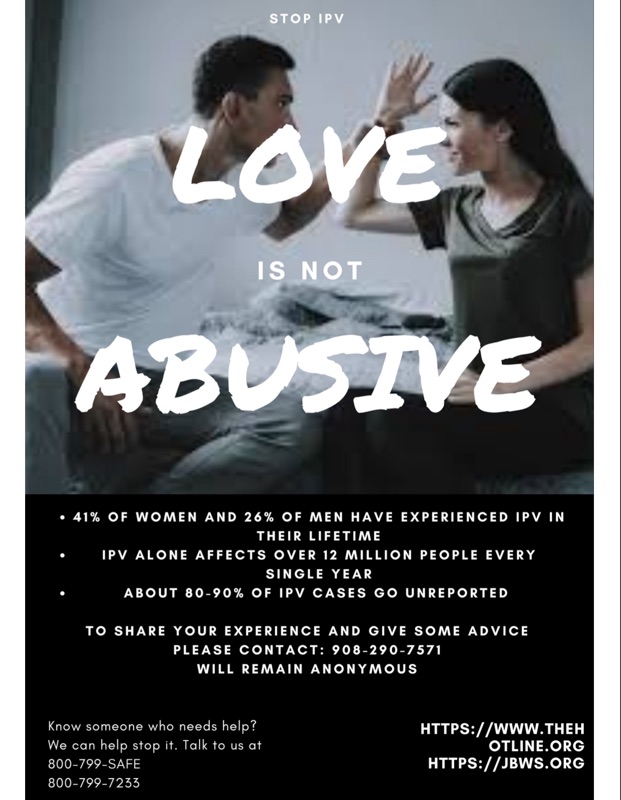 my project will be focusing on /intimate partner violence by using flyer sharing helpful outlets and information that will be hung up around the neighborhood. I inserted a phone number for IPV victims to share personal experiences or give some advice. I’m hoping with that peers will feel comfortable to open up about IPV/DV abuse. I want others to feel heard and bring full awareness. My goal is to also educate people on how many outlets there are and how much support they have . The quote I decided to touch base on was “A meme might not change the world, but it might change someone’s perspective.” Because i understand my flyer won’t change the world but will change someone perspective .
my project will be focusing on /intimate partner violence by using flyer sharing helpful outlets and information that will be hung up around the neighborhood. I inserted a phone number for IPV victims to share personal experiences or give some advice. I’m hoping with that peers will feel comfortable to open up about IPV/DV abuse. I want others to feel heard and bring full awareness. My goal is to also educate people on how many outlets there are and how much support they have . The quote I decided to touch base on was “A meme might not change the world, but it might change someone’s perspective.” Because i understand my flyer won’t change the world but will change someone perspective .
I chose to touch this topic because not enough people know that roughly about 41% of woman and 26% of men have experienced IPV in a lifetime and that is not it okay! You would be surprised or maybe you wouldn’t but IPV alone affects over 12 million people every single year. We as people shouldn’t and won’t stand for this. IPV has taken a huge toll on people both mentally and physically but what they don’t know is there are outlets.
There are numerous domestic violence hotlines for anyone suffering from DV. Free online support groups are also available for victims of DV. Anyone going through abuse or dealing with ptsd from it shouldn’t go through it alone. Together we have to bring more awareness it’ll help many more people open up. Many IPV cases go unreported with estimates ranging from 50% to 80% and that may be because of fear, lack of resource or even attachment but our job is to bring light to it. so if you or anyone else are dealing with or have been IPV don’t be afraid to speak up and get the help you need. 800-799-SAFE (800-799-7233)
After hanging up this flyer up on my mom’s board at work she’s received a lot of feedback about how helpful this information is may be for others . I plan on passing out flyers to classmates to further advocate as well.
Art Intervention: Luis Martinez
RECYCLING PAPER

